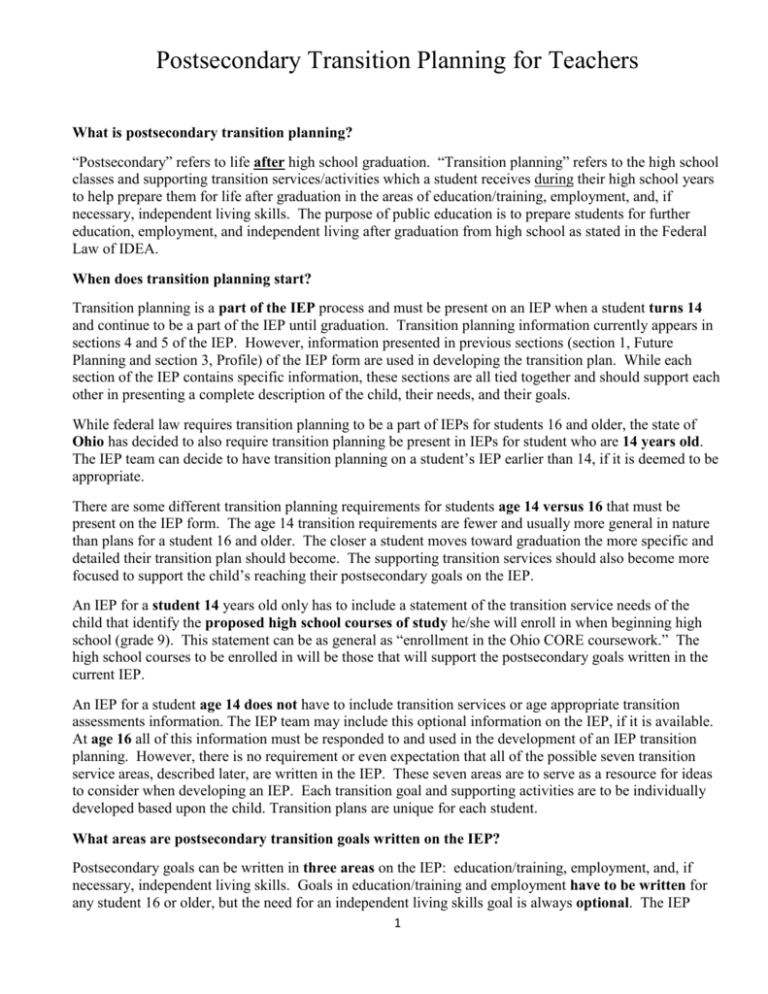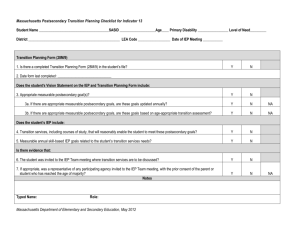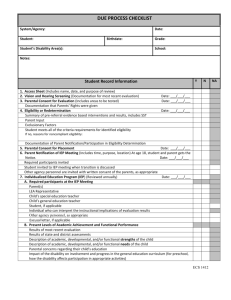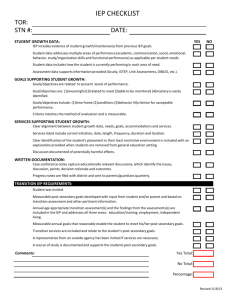Postsecondary Transition Planning for Teachers - Ross
advertisement

Postsecondary Transition Planning for Teachers What is postsecondary transition planning? “Postsecondary” refers to life after high school graduation. “Transition planning” refers to the high school classes and supporting transition services/activities which a student receives during their high school years to help prepare them for life after graduation in the areas of education/training, employment, and, if necessary, independent living skills. The purpose of public education is to prepare students for further education, employment, and independent living after graduation from high school as stated in the Federal Law of IDEA. When does transition planning start? Transition planning is a part of the IEP process and must be present on an IEP when a student turns 14 and continue to be a part of the IEP until graduation. Transition planning information currently appears in sections 4 and 5 of the IEP. However, information presented in previous sections (section 1, Future Planning and section 3, Profile) of the IEP form are used in developing the transition plan. While each section of the IEP contains specific information, these sections are all tied together and should support each other in presenting a complete description of the child, their needs, and their goals. While federal law requires transition planning to be a part of IEPs for students 16 and older, the state of Ohio has decided to also require transition planning be present in IEPs for student who are 14 years old. The IEP team can decide to have transition planning on a student’s IEP earlier than 14, if it is deemed to be appropriate. There are some different transition planning requirements for students age 14 versus 16 that must be present on the IEP form. The age 14 transition requirements are fewer and usually more general in nature than plans for a student 16 and older. The closer a student moves toward graduation the more specific and detailed their transition plan should become. The supporting transition services should also become more focused to support the child’s reaching their postsecondary goals on the IEP. An IEP for a student 14 years old only has to include a statement of the transition service needs of the child that identify the proposed high school courses of study he/she will enroll in when beginning high school (grade 9). This statement can be as general as “enrollment in the Ohio CORE coursework.” The high school courses to be enrolled in will be those that will support the postsecondary goals written in the current IEP. An IEP for a student age 14 does not have to include transition services or age appropriate transition assessments information. The IEP team may include this optional information on the IEP, if it is available. At age 16 all of this information must be responded to and used in the development of an IEP transition planning. However, there is no requirement or even expectation that all of the possible seven transition service areas, described later, are written in the IEP. These seven areas are to serve as a resource for ideas to consider when developing an IEP. Each transition goal and supporting activities are to be individually developed based upon the child. Transition plans are unique for each student. What areas are postsecondary transition goals written on the IEP? Postsecondary goals can be written in three areas on the IEP: education/training, employment, and, if necessary, independent living skills. Goals in education/training and employment have to be written for any student 16 or older, but the need for an independent living skills goal is always optional. The IEP 1 team will annually make the decision as to whether or not an independent living skill is needed for the student’s transition plan during the IEP meeting. What is meant by “transition services”? Transition services are the high school courses and other activities/services which are provided to the student during their high school years that support the student reaching their IEP postsecondary goals. Transition services/activities are to be coordinated and with a purpose for each student that: are provided for specific reasons to improve their academic achievement and functional performance to help them move from high school to their post high school life, and are based on the student’s needs, strengths, preferences, and interests. What are the types or areas of transition services/activities a school should consider? Seven transition service categories of services or activities have been identified that a student may participate in during the high school years in support of their IEP postsecondary goals. The seven categories with some examples are: 1. instruction- classes, study skill training, tutoring, organizational skills training 2. community experiences- job shadowing, service learning project 3. development of adult living objectives- resume development, apply for SAT/ACT college tests, guidance counseling, job placement service 4. related services- develop peer supports, computer skills training, transportation needs, speech-language therapy, occupational or physical therapy, educational aide, nursing services, guidance counseling 5. daily living skills training- diet and menu training, driver’s education, budgeting, checkbook use, appropriate dress, handling emergencies 6. age-appropriate assessments- Ohio Graduation Test, ACT/SAT tests, curriculum-based assessments, aptitude testing, interest inventories 7. linkage to adult services- referral to BVR or MR/DD, plan with disabilities services at a college, support for obtaining a YMCA membership A service/activity may be viewed as appropriate in more than one of these seven categories. The school’s focus should be on providing the most appropriate activities for a student and not what category to place it under. Every category does not have to be addresses every year. The categories are only offered for guidance in developing a transition plan that truly is designed to help the student reach their postsecondary transition goals. Can a student change their transition plans? The student’s transition plan can and often will change as the student moves from age 14 to high school graduation. The student may think at age 14 he/she will attend the vocational school and then enter the work force, but later decide in high school that attending college is what he/she will do after graduating. The IEP would then be change in the stated postsecondary goals and the transition activities the school would provide would also change in support of the new transition goals. What is the role of the student and parents in transition planning? Any time postsecondary transition planning is to be discussed at an IEP meeting both the student and parents are to be invited to attend the meeting. Productive transition planning particularly requires the student and parents be highly involved in and take leadership roles in this area. Use the ODE special 2 education PR-02 Parent Invitation form to document you invited both the student and parents to attend the IEP meeting. You must be sure to have the appropriate boxes checked in the participants section of the form to be able to verify your invitation. Keep this form on record for future documentation needs. How do I involve an outside of school service agency in a transition plan? If any outside agency (i.e. MRDD, Social Security, BVR) is requested to attend an IEP meeting by the school system due to transition planning needs, then the school must notify the parents ahead of the IEP meeting and receive their permission for the agency to attend the meeting. You have to document that you did this by using the ODE special education PR-02, Parent Invitation form. Check the “Other” box for participants and write what agency has been invited to the IEP meeting. Once the parents return the form with their signature of approval, keep it for future documentation you must provide, if required. Outside agencies can provide services or pay for services to be provided to a student that the school system might not have the ability to offer. What is an age appropriate transition assessment? This assessment is an ongoing process by the school in collecting information on the student’s needs, strengths, preferences, and interests as they relate to the child’s current and future working, educational, living, and personal and social environments. “Age appropriate” refers the student’s chronological age and not their mental age. There are both formal and informal ways a school can gather age appropriate information on a student that meet transition assessment requirements. Some examples of formal age appropriate transition assessments are: results on district-wide and state-wide tests, (Ohio Achievement Assessment and Ohio Graduation Test) adaptive behavior/daily living skills assessments, interests inventories, aptitude tests, and intelligence test results as part of the ETR process. Some examples of informal age appropriate transition assessments are: interviews and questionnaires given to students and parents to help determine the student’s needs, strengths, preferences, and needs related to their anticipated post-school goals, direct observations of student performances in their school environments, (i.e. classroom, cafeteria, extra-curricular activities), curriculum-based assessments conducted by the teacher to help develop specific curriculum and instructional plans for a student, and learning styles inventory and study skills assessment Age appropriate transition assessments do not have to be included on an IEP for a student age 14 or younger. They do have to be included on an IEP for students age 16 and older. Only a summary of the information gained from an assessment and the type (i.e. pencil and paper, computer assessment, etc.) needs to appear on the IEP in section 4. 3 Age appropriate transition assessments are not required to be conducted every year nor for each of the postsecondary goal areas of education/training, employment, and, if necessary, independent living skills. However, it is best to do some assessments each year to gather new information. To get free examples of numerous free age appropriate transition assessments go to the web site www.khake.com. What are the criteria for developing postsecondary transition plans on an IEP? The criteria for a postsecondary transition goal and an annual IEP goal are not the same. When a postsecondary transition goal is being written (section 4 of IEP), these three criteria are to be used: A the goal has to be written to occur after high school graduation, B the goal has to be measurable. “Measurable” for a postsecondary goal actually means it can observed (i.e. enroll, graduate, employed, join) if the goal was met or not, and C the goal has to be written with positive (will) expectations. When positive goal expectations are used, then the likelihood it will be achieved are significantly increased. Thus, used the term “will” and not terms such as: “wants to,” “plans on,” “is thinking about,” “would like,” “dreams of,” or “is interested in” when writing the goals. Remember, there are three possible postsecondary transition goal areas. The areas of: 1 education/training must be addressed on the IEP each year starting at age 16. The difference between education and training in transition planning is simple. “Education” refers to a student who plans to attend a four degree college program after graduation from high school. The term “training” refers to attending a one or two year program. 2 employment. This must also be addressed on the IEP each year starting at age 16. 3 independent living skills. This is always optional to be addressed, no matter what the age of the student. The IEP team will make the decision as to whether or not to have this goal on the IEP based upon current student information in this area. You are highly encouraged to address this goal area each year even though it is optional. What are examples of good postsecondary transition goals? Below are two examples of what transition goals could be written as with the “A,B,C” criteria and “1,2,3” goals areas identified. This goal involves both education (1) and employment (2). 4 “After graduation from high school (A), Beth will (C) enroll (B) at Shawnee State University (1) in the field of elementary education (1). She will (C) graduate (B) with an elementary education degree (1) and be employed (B) as a teacher (2).” The following is an example of a postsecondary transition goal for an independent living skill (3). “After graduation (A), Beth will (B) participate (C) in community activities (3) by attending (B) the movie theater (3), joining (B) a bowling league (3), and participate (B) in YMCA classes (3) of interest to her. She will (C) also do her own clothes shopping (3) and financial management (3) by developing (B) and implementing (B) a budget (3).” Postsecondary goals are not the services/activities and courses a student takes during their high school years. These are only steps toward reaching a postsecondary goal. Postsecondary goals are what will occur after high school. What information do I need to help in developing good transition goals and their supporting services/activities? When involved in transition planning, it is important for teachers, students and parents to: know the student’s needs, strength, preferences, and interests, know the present levels of performance of their child, know what skills and abilities they want the child to have by high school graduation, understand what the differences are between their present performances versus those desired future performances, and decide what needs to be done to close the gap between them with the time remaining before his/her high school graduation. Once an overall transition plan has been jointly developed by the student, parents, and school staff; various methods and frequencies of evaluation should be decided upon to determine how progress is being made toward their postsecondary goals. Remember, these goals can change and thus the transition services/activities and high school courses of study (classes) would likely then change. What is the connection between section 6, “Measurable Annual IEP Goals” and section 5, “Measurable Postsecondary Goals” on an IEP? Most, if not all, of the annual IEP goals written in section 6, Measurable Annual Goals, of the IEP are designed to support one or more of the broader postsecondary goals written in section 5. This is why the number assigned to the annual goal in section 6 is also reported in section 5 to indicate how it supports a particular postsecondary goal or goals. These annual IEP goals should be viewed as yearly steps the school will implement to help a student reach their future postsecondary goals in education, employment, and, if necessary, independent living skills. Annual goals are written to improve identified weaknesses in areas of academic achievement and functional performance identified in the “Present Levels of Performance” of section 6. What are individual and school liabilities in writing IEPs that have such positive expectations, “will,” written for postsecondary transition goals? Neither an individual school staff member nor the school district can be held liable for a student with a disability not reaching a postsecondary goal stated on the IEP. IDEA services and rights do not extend beyond high school graduation. However, schools and individuals are held liable for providing during the high school years the courses of study (classes) and the transition services/activities that would support 5 the student in being able to begin obtaining their postsecondary goals. The school is also not guaranteeing passage of any high school course written on an IEP for transition planning. However, the school is responsible for providing the necessary supplementary aides and supports along with appropriate accommodations or modification to support the student’s successful participation in those classes. Is there someone responsible to oversee the implementation of the IEP? One person who is knowledgeable about special education and the child’s IEP is to be responsible for overseeing the implementation of the IEPs. This person could be a guidance counselor, intervention specialists, director of special education, principal, or other individual deemed appropriate by the school district. This responsible person is not documented on the IEP. What is a “Summary of Performance?” In the senior year before a student graduates, the school is to provide students with a Summary of Performance document. This contains information which focuses on the accomplishments of the student in high school and recommended future transition needs he/she should pursue in education, employment, and, if necessary, independent living skills. Their academic achievements and current functional performance must be included in the document. Currently, there is no form approved to use for this summary by the Office for Exceptional Children (OEC), only a requirement to provide it to students. OEC has a Summary of Performance document that can be found on their www.edresourcesohio.org website under “Optional Forms.” It is recommended that districts use this form as it addresses all of the required areas. Where can I find more information on Summary of Performance? The OEC website in the Ohio Department of Education (ODE) contains this information. Go to WWW.ODE.state.oh.us and do a term search of “summary of performance.” This will take you to an OEC link that has a title of “Statewide Special Education Conference” that was held on September 24-24, 2008. Numerous topics are presented here, including information on Summary of Performance requirements. Where can I get more information on transition planning? The National Secondary Transition Technical Assistance Center (NSTTAC) is the best source. Their website is www.nsttac.org. If you go to “www.nsttac.org/tm_materials/Default.aspx” you will see excellent information. This site will give you multiple examples on writing postsecondary goals and define key terminology in transition planning. How can I know if a transition plan is appropriate according to Office for Exceptional Children (OEC) staff? Again, go to www.nsttac.org website to get the answer to this question. Locate the link to “NSTTAC Indicator 13 Checklist: Form B” and click on it. You will see a form that has eight questions to answer for the three possible transition goal areas or education/training, employment and independent living skills. These questions are the same ones OEC staff will use to evaluate IEP transition plans. Where can I get more information on age appropriate transition assessments? 6 Again, go to www.nsttac.org and click on the link for age appropriate transition assessments. Terms will be defined and examples of the types of assessments will be identified. In addition to the www.khake.com website previous discussed, more examples of assessments can be found at the School to World and Career Connections websites (www.iccweb.com/careerfocus/userinput website. What is the “Guidance Document” and how can it help me? OEC developed an excellent source of information on all areas of special education that you should become familiar with to help answer most of your special education questions. The easiest way to locate is the website www.edresourcesohio.org. Here you will find the guidance for Ohio Operating Standards link along with other special education information such as required special education forms, annotations for the ETR and IEP forms. Material developed by: John Morgan, Transition Consultant State Support Team, Region 15 100 East Third Street PO Box 578 Piketon, Ohio 45661 1 740 289-4171 ext. 4218 or 1 800 282-4597 ext. 4218 Email: john.morgan@region15.scoca-k12.org Revised: January 13, 2012 7





